Decorated Bone Pin
June 2008
By Rebecca Morehouse, MAC Lab State Curator
In the summers of 1970 and 1971, the Lower Delmarva Chapter of the Archeological Society of Maryland and the Division of Archeology, Maryland Geological Survey, conducted a joint research project at the Reeves archaeological site located near Salisbury in Wicomico County, Maryland. This site dates to the Woodland period (1000 B.C. to A.D. 1600) and is one of the few excavated Woodland Indian village sites on Maryland's Eastern Shore.
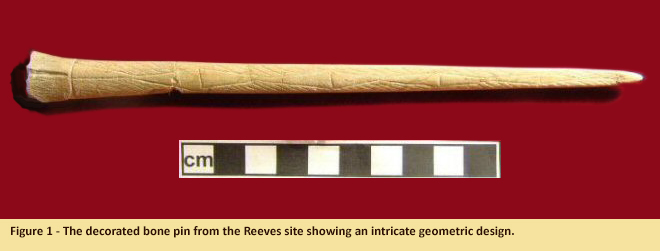
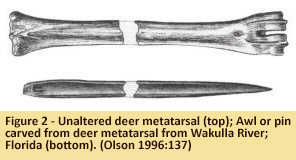 One of the features from the site's Late Woodland component (c. A.D. 1000-1600) yielded an intricately decorated bone pin unlike any other found in the State of Maryland's archaeological collections (Figure 1). This bone pin measures 20.75 cm long from head to tip and tapers to a blunted point. The pin, made from a deer metatarsal or lower leg bone, is decorated with an incised cross-hatching or checkerboard-like pattern (Figure 2).
One of the features from the site's Late Woodland component (c. A.D. 1000-1600) yielded an intricately decorated bone pin unlike any other found in the State of Maryland's archaeological collections (Figure 1). This bone pin measures 20.75 cm long from head to tip and tapers to a blunted point. The pin, made from a deer metatarsal or lower leg bone, is decorated with an incised cross-hatching or checkerboard-like pattern (Figure 2).
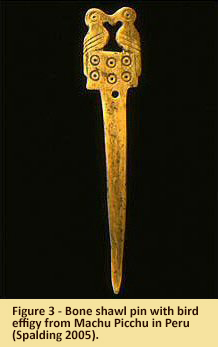 Because of the fragile nature of bone artifacts, they rarely survive intact in the archaeological record. There are very few examples of bone pins from archaeological sites that retain their head, shank and tip (Jeffries 1997: 470). The bone pin from the Reeves site is no exception. It was discovered in five pieces and had to be mended. Part of the head of the pin appears to be missing and may have broken off either before or after this artifact was discarded or lost. It is impossible to know what the head may have looked like, but it may have had a carved animal or human effigy or perhaps was incised in the geometric patterning found on the pin's shank (Figure 3).
Because of the fragile nature of bone artifacts, they rarely survive intact in the archaeological record. There are very few examples of bone pins from archaeological sites that retain their head, shank and tip (Jeffries 1997: 470). The bone pin from the Reeves site is no exception. It was discovered in five pieces and had to be mended. Part of the head of the pin appears to be missing and may have broken off either before or after this artifact was discarded or lost. It is impossible to know what the head may have looked like, but it may have had a carved animal or human effigy or perhaps was incised in the geometric patterning found on the pin's shank (Figure 3).
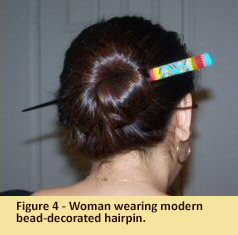 Originally catalogued as a bone awl, this artifact was more likely used as a pin or fastener for hair or clothing (Figure 4). Prehistoric peoples used pins for hairdressing and to fasten clothing or textiles that may have served as cloaks or other garments (Beaudry 2006:11). Awls tend to be ground and polished to sharp points and would have been used for piercing and perforating leather and hides (Brennan 1975: 152). The pin from the Reeves site has a very dull point which would not lend itself to such work, but would make sense if used for hair or clothing, as an intentionally dulled tip would prevent accidental injury while being worn. The pin also shows some insignificant wear to the cross-hatched pattern at its tip and virtually no wear to the pattern towards the head of the pin, suggesting that this artifact was not used for perforating rough material.
Originally catalogued as a bone awl, this artifact was more likely used as a pin or fastener for hair or clothing (Figure 4). Prehistoric peoples used pins for hairdressing and to fasten clothing or textiles that may have served as cloaks or other garments (Beaudry 2006:11). Awls tend to be ground and polished to sharp points and would have been used for piercing and perforating leather and hides (Brennan 1975: 152). The pin from the Reeves site has a very dull point which would not lend itself to such work, but would make sense if used for hair or clothing, as an intentionally dulled tip would prevent accidental injury while being worn. The pin also shows some insignificant wear to the cross-hatched pattern at its tip and virtually no wear to the pattern towards the head of the pin, suggesting that this artifact was not used for perforating rough material.
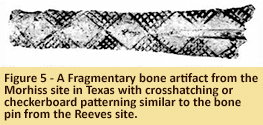 Many archaeologists believe that pins for hair or clothing would be decorated and used as ornaments while a more utilitarian object such as an awl would be undecorated. Considering the majority of awls found at archaeological sites in Maryland are undecorated, this seems like a reasonable conclusion. Archaeologists working at the Morhiss site in Texas excavated a fragmentary bone artifact with a cross-hatched or checkerboard pattern similar to the pin from the Reeves site (Figure 5). They concluded that such curving, flattish bone artifacts with intricate incised designs in checkerboard patterns and spirals were most likely hairpins (University of Texas 2006).
Many archaeologists believe that pins for hair or clothing would be decorated and used as ornaments while a more utilitarian object such as an awl would be undecorated. Considering the majority of awls found at archaeological sites in Maryland are undecorated, this seems like a reasonable conclusion. Archaeologists working at the Morhiss site in Texas excavated a fragmentary bone artifact with a cross-hatched or checkerboard pattern similar to the pin from the Reeves site (Figure 5). They concluded that such curving, flattish bone artifacts with intricate incised designs in checkerboard patterns and spirals were most likely hairpins (University of Texas 2006).
Bone and related materials, such as antler, horn, and turtle shell, was readily available and a highly useful resource for the native peoples of North America. A number of methods were used to transform bones and antlers into finished tools. The simplest technique was to place a leg bone on end, then strike it in the middle with a stone. This would split the bone into a number of fragments, which would then be modified into various tools, perhaps incised with a design or patterns, then polished with a fine-grained grinding stone (Royal Alberta Museum 2005).
Bone may not survive well in most archaeological environments over hundreds or thousands of years, but it does have a durability that made it desirable for making many kinds of implements and utensils for everyday use. Bone was made into arrow and harpoon points; fishhooks; weaving tools; hide scrapers; pottery-making tools; pendants; hair and clothing fasteners; gaming pieces; musical instruments; and various ceremonial objects.
| References |
|
| Beaudry, Mary C. |
| 2006 |
Findings: The Material Culture of Needlework and Sewing. Yale University Press, New Haven and London. |
|
| Brennan, Louis A. |
| 1975 |
Artifacts of Prehistoric America. Stackpole Books, Harrisburg. |
|
| Jefferies, Richard W. |
| 1997 |
Middle Archaic Bone Pins: Evidence of Mid-Holocene Regional-Scale Social Groups in the Southern Midwest. American Antiquity 62 (3): 464-487. |
|
| Olson, Stanley J. |
| 1996 |
Mammal Remains from Archaeological Sites, Part 1: Southeastern and Southwestern United States. Papers of the Peabody Museum of Archaeology and Ethnology 56 (1), Harvard University. |
|
| Royal Alberta Museum |
| 2005 |
Archaeology: Prehistoric Technology. Electronic document, http://www.royalalbertamuseum.ca/research/culturalStudies/archaeology/technology.cfm, accessed May 20, 2008. |
|
| Spalding, Tim |
| 2005 |
Machu Picchu on the Web. Electronic document, http://www.isidore-of-seville.com/machu/9-2.html, accessed May 21, 2008. |
|
| University of Texas |
| 2006 |
Prehistoric Texas, South Texas Plains, Artistic Impression. Electronic document, http://www.texasbeyondhistory.net/st-plains/artistic/index.html, accessed May 21, 2008. |
|